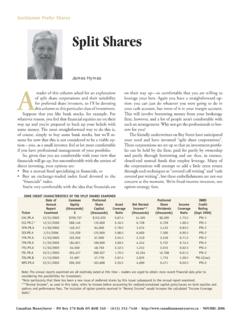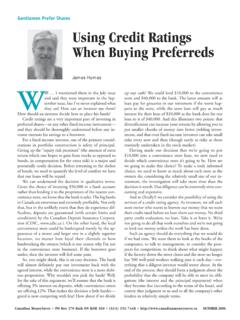Transcription of Gentlemen Prefer Bonds Yields of Bonds and Strips
1 Canadian MoneySaver PO Box 370, Bath, ON K0H 1G0 (613) 352-7448 2009 Gentlemen Prefer BondsYields of Bonds andStrips James HymasUnlike equity investors, bond analysts must havesome vague idea of what they re talking s not enough to exhort, Peak Oil .. mum-ble mumble .. buy ConocoPhillips! With theasymmetrical nature of bond returns (you can lose a lotmore than you can possibly win) it requires investors tounderstand the nature of the risks they re taking and toquantify every penny of their expected income expected return is usually expressed as yieldto maturity (YTM); yield -to-worst (YTW) may be usedwhen considering an instrument with embedded may be inherent in these calculations (how else tocompare a floating rate issue with a real return bond ?)
2 , butdefining these approximations and understanding them isa useful stage in the process. Analyzing a model of expectedreturn and determining its weak points is a stage that someinvestors in sub-prime paper might well wish they had notskipped over so blithely!It must be understood that bond Yields are calculated ac-cording to conventions. There is no right or wrong wayto calculate a yield , any more than it is right or wrong to driveon the right-hand side of the road. If you are either driving ordiscussing bond Yields with a salesman, however, you need toknow which convention is being used because, just as is thecase with highway driving, you ll be bearing all the conse-quences of running counter to consensus!The convention used in Canada is described in lovingdetail by the Investment Industry Association of Canadain its publication Canadian Conventions in Fixed IncomeMarkets, available on-line at most important things to remember are: All coupons are evaluated at the same yield in both YTMand IRR calculations; YTM is not equal to the Internal Rate of Return (IRR); YTM includes accrued interest.
3 And The accrued interest used for YTM calculations is notnecessarily the same as the accrued interest used for set-tlement should also mention that Yields reported for moneymarket instruments have a convention all their own:P = 100 / (1 + YD/365)WhereP = priceY = yieldD = days to maturityAll Individual Yields are Considered Equalin the CalculationTo realize the posted yield on a particular bond , all cou-pons must be reinvested at that same posted yield to thematurity of the bond . (There are some variants of yieldanalysis that attempt to quantify the effect of differing re-investment rates, but these essentially useless calculationswill not be discussed here.)This is the great weakness of YTM analysis.
4 For seriouswork, one must use the zero coupon curve , which is con-structed so that every cash flow is assigned a particular are various methods of performing this mathematicalanalysis. One may be found in the Winter 2004-05 editionof The Bank of Canada Review, available online at Is Not Equal to the Internal Rate ofReturnThe compounding frequency of IRR is annual; the com-pounding frequency of YTM is equal to the period betweenits coupon payments, which is almost always six months(two coupons annually).This difference in compounding frequency can lead todramatic differences. Wikipedia takes as an example ( ) a 30-yearzero coupon bond with a face value of $100, priced at a yield -to-maturity of 10%, claiming that this implies aprice of $ today on the basis of 100 / ( )30 = $ calculation uses annual compounding, but if one is tocalculate yield to maturity in a manner consistent with bondCanadian MoneySaver PO Box 370, Bath, ON K0H 1G0 (613) 352-7448 2009calculation, it is necessary to compound semi-annually,halving the interest rate but doubling the number of peri-ods: 100 / ( )60 = $ A price of $ implies a semi-annual YTM of Microsoft Excel XIRR() function may be usedto calculate IRR, which may then be converted to conversion formula is.
5 (1 + YTM/2)2 = 1 + IRRSo YTM = 2 x ([1+IRR] 1)It will be noted that the figure two , used both as adivisor and an exponent on the left hand side of the upperequation, results from the standard coupon frequency twice per year. YTM is expressed as an annual figure butcalculated per period. If we were, for example, convertingto the (quarterly) preferred share convention, with quar-terly payments, we would substitute four .YTM Includes Accrued InterestBonds come with coupons, usually paid is a convention that the amount to be paid when a trans-action is settled will include not just the negotiated price(expressed in terms of dollars paid per $100 par value), butan additional amount to compensate the seller for the pe-riod he has held the bond since the previous most common mistake made when calculating YTMis not including the accrued interest in the total cost of thebond.
6 A ten-year bond sold at par with settlement on itscoupon date (and therefore with no accrued interest) andsemi-annual coupons of $2 each will have a calculated YTMof 4%, which should not be surprising. But consider thesituation when the bond is traded exactly three months later,at the half-way point between coupon the yield on the bond has not changed, the price ofthe bond will continue to be quoted at 100. If no accruedinterest adjustment is made, however, the bond s IRR wouldbe and its YTM would be However, whenaccrued interest in included in the price, to make the totalconsideration paid for the bond $101 (the $100 price plusaccrued interest of half a coupon, or $1) we arrive back at4% or as close to it as allowed by our selection of dates toapproximate half a year will allow!
7 Accrued Interest Calculation ConventionsA careful investor, attempting to verify all the informa-tion reported to him by his broker, may sometimes runafoul of accrued interest conventions. For the precise rules,the reader must refer to the IIAC publication referencedabove. In general, it should be remembered that in Canadathe Actual / 365 (Canadian bond ) convention is used forcalculation of Yields . This is different from the Actual/365(ISDA) convention used for swaps and the Actual/365 convention used for money market instruments. For calcu-lation of accrued interest for settlement purposes, however,the Actual/Actual convention is corporate Bonds trade with accrued interest de-fined according to another convention.
8 This should be, butis not always, specified in the prospectus or pricing supple-ment, usually available from the System for ElectronicDocument Analysis and Retrieval (SEDAR, at ).Like most conventions, the origins of these various con-ventions are lost in the mists of time, throwbacks to an erawhen not only was finance a local affair, but when lack ofcomputers meant that traders had to depend on yield booksto convert between yield and price. Happily, our traditionsare not as old as they are in Europe governmentbonds can trade with negative accrued interest!Market Yields of Strip BondsThe credit crunch has affected many things, but stripbond trading does not appear to be one of them. The In-vestment Industry Association of Canada has reported ( ) thattrading of provincial strip Bonds was essentially unchangedin 2008 relative to 2007 at about $60 billion, while trad-ing of provincial Bonds themselves declined 13% to about$517 conventions regarding bond yield calculations haveimplications for Yields and pricing of strip Bonds that areimportant for investors seeking to determine whether stripbonds or coupon Bonds are a better choice for their , the market value of a bond (including ac-crued interest) should be equal to the sum of the value ofits constituent coupons and principal.
9 So, consider the de-cision by an investment dealer to strip a bond and sell itsconstituent part to its retail clients in a market environ-ment in which the yield curve is upward sloping (that is, alonger term implies a higher yield ).The dealer may buy the bond at a yield -to-maturity of5%, which implies that, when each coupon and the princi-pal repayment is discounted at this rate, an investor will beindifferent as to whether he buys the whole or the , consider the effect on the package when the dealersells the first coupon, due within six months. This may besold at a lower yield that reflects its term and hence thedealer will receive a higher price for it than assumed giventhe 5% yield on the bond as a order to compensate for this, and keep the value ofthe sum equal to the value of the parts, the yield on all theother cash flows must therefore be assumed to be when the second coupon is sold, its short term againallows a lower yield for the transaction and the longer-termcoupons in the position are again increased in yield to com-Canadian MoneySaver PO Box 370, Bath, ON K0H 1G0 (613) 352-7448 2009pensate.
10 Once this process has been completed, we can drawtwo important conclusions: The zero-coupon curve will be steeper than the nominalyield curve; and The yield difference between the zero-coupon curve andthe nominal yield curve at the long-term end will bedependent on the steepness of the nominal enables brokerages to profit enormously from strip-ping Bonds in a steep- yield curve environment. Investorshave reasonably valid benchmarks for the shorter-term stripsbut, transfixed by spreads that are simply a mathematicalconsequence of convention, may be willing to accept a lower spread against long Bonds than should be the a 10 YearThe table on the right has been calculated using a deal-er s bid-side quotations for Ontario Bonds and Strips as ofApril 9.


